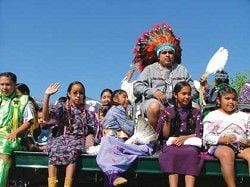Tribal encampment plays key role in Chief Joseph Days
Published 7:00 am Tuesday, July 26, 2022
JOSEPH — Chief Joseph Days Rodeo is a mashup of Western culture with both roping and riding action in the Harley Tucker Arena as well as the dancing, singing and feasting of the tribal encampment.
In the “old days,” according to Ralph Swinehart, there were 200 tepees on the rodeo grounds during Chief Joseph Days. Slowly the tribal members stopped coming.
“In 1986 it trickled down to only three tepees,” Swinehart said.
In 1988, Swinehart said, a couple Wallowa County residents — Steve Zollman and Bruce Womack — went to visit Nez Perce descendants of the Wallowa Band on the Confederated Tribes of the Umatilla Indian Reservation, the Confederated Tribes of the Colville Reservation and the Nez Perce Indian Reservation to ask why they were no longer coming. They were told they were not invited.
“Bruce and Steve got together with Milley Fraser and welcomed them back,” Swinehart said.
Tribal members from the Nez Perce Reservation in Lapwai, Idaho, May Taylor and Horace Axtell, as well as Soy RedThunder from Nespelem, Washington, on the Colville Reservation, and Priscilla and Fernmore Craig from the Confederated Tribes of the Umatilla Reservation restarted it.
Swinehart said Don and Rosemary Green from Wallowa County and the Craigs brought fish and organized a potluck that now feeds hundreds of people a year.
Jean Pekarek has been volunteering at the friendship feast as long as Swinehart.
“In 1988, I got word that there were going to be some tribal people bringing salmon, and people in the community wanted to come and bring side dishes,” Pekarek said. “I went, and as the years went on, it started growing.”
In 1991, tribal dancing was held at the Joseph High School gym, Pekarek said, and in 1998 the dancing was moved to the rodeo grounds’ encampment.
Over the years, there have been several improvements to the encampment facilities, Swinehart said.
“We’ve gone through several different arbors,” Swinehart said. “The first year we had a lodgepole frame with shade tarps and in 1990 the first arbor was constructed.”
About five years ago, a permanent arbor was constructed with plenty of room for the feast, and after the chairs and tables are picked up, the dancing and drumming begin.
While the tribal encampment needed some reinvigoration in the late ’80s, Swinehart said tribal members have always been in the parade. A vintage car collector for more than 30 years, he has driven some of the elder tribal members who no longer ride horseback in his Model A Ford.
Today, the chief salmon cook is Joe McCormack and the Stangel Buffalo Ranch donates burgers. Ahead of time, volunteers get together to make patties out of 250 pounds of ground meat, said Shelley Rogers, a rodeo committee member who helps organize the friendship feast and other encampment details.
This year the local Rotaract Club — a Rotary Club for younger adults — are in charge of preparing and freezing the burgers ahead of the feast..
Rogers said Brenda Axtell, of Lapwai, is helping organize other aspects of the encampment remotely.
“It takes a lot of coordination with phone calls, emails,” Rogers said.
While Swinehart, Pekarek and Rogers are dedicated to their labor of love and hospitality, each confessed to being over 70 years old.
“We are putting out the word for anyone to get involved, especially young people,” Swinehart said.
The Chief Joseph Days Rodeo Friendship Feast is held after the grand parade at noon on Saturday, July 30. Those wanting to attend are asked to bring a side dish to share. Dancing and drumming will follow the feast.






